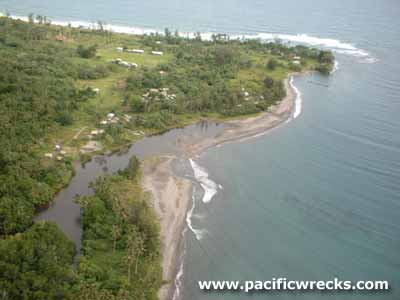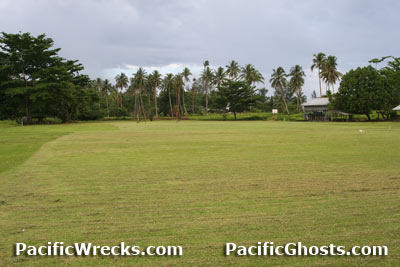|
|
|
|
| Missing In Action (MIA) | Prisoners Of War (POW) | Unexploded Ordnance (UXO) |
| Chronology | Locations | Aircraft | Ships | Submit Info | How You Can Help | Donate |
|
  USMC Dec 23, 1943  USMC December 1943  Stan Cannon 1944  John Williams 1944  USN c1944  USN September 8, 1945  David Paulley 1982  Harumi Sakaguchi 2003  Justin Taylan 2007 |
Location Torokina Airfield located at Cape Torokina (Torokina Point) on the west coast of Bougainville bordering Empress Augusta Bay. Also known as Cape Torokina Airfield. To the west is Cape Torokina (Torokina Point). Inland to the north is Piva. Roughly 200 miles to the northwest is Rabaul. Prewar and during the Pacific War, part of the Kieta District in the Territory of New Guinea. On September 16, 1975 became part of Bougainville Province in Papua New Guinea (PNG). On June 25, 2002 became part of the Autonomous Region of Bougainville (AROB). Construction On November 1, 1943, after the U.S. landing at Torokina, U.S. Navy (USN) Naval Construction Battalion (NCB) "Seabees" began construction of a single runway parallel to the coast surfaced with marston matting / Pierced Steel Planking (PSP). On November 24, 1943 while still under construction, a U.S. Marine Corps (USMC) SBD Dauntless force landed on the runway. By early December 1943, in only forty days the runway was completed and by December 9, 1943 becomes operational. Wartime History Torokina Airfield was primarily used by fighter aircraft. On December 10, 1943 the first planes to arrive were seventeen F4U Corsairs from Marine Fighting Squadron 216 (VMF-216) plus four or five SBD Dauntless dive bombers. A Marine-manned New Zealand ground control radar unit was set up, and reached operation about the time the airfield was ready for flight operations. Torokina Airfield was used by the United States Navy (USN), United States Marine Corps (USMC), U.S. Army Air Force (USAAF). After January 1, 1944 Royal New Zealand Air Force (RNZAF) aircraft also used Torokina Airfield. By December 30, 1943 nearby Piva North Airfield (Piva Yoke) opened and became the primary bomber strip and Piva South Airfield (Piva Uncle) opened as another fighter strip. On March 8, 1944 in conjunction with the Imperial Japanese Army (IJA) counterattack against the American beachhead area around Torokina, Japanese artillery bombards Piva Airfield. On March 9, 1944 during the early morning, Torokina Airfield was shelled, forcing aircraft to withdraw to avoid being damaged on the ground. On March 29, 1944 B-24 Liberators from the 307th Bombardment Group (307th BG) carry out their first daylight raid against Truk bombing Eten Airfield; the mission is staged from their base at Munda Airfield via Torokina Airfield to refuel and arm then to bomb Truk and return. John Williams of ACORN 13 adds: "Our unit operated the tower we fed and quartered the American pilots, we armed and fueled the planes and any other duties necessary to operate an airbase. Sorties of F4Us, TBF torpedo bombers and SBD dive bombers were flown off the strip. Our main target was Rabaul. Also the Kiwis flew the old P-40s from there. Boyington took off from that field the day he was shot down over Rabaul." Allied units based at Torokina Airfield U.S. Navy (USN) VC-40 (TBF) ACORN 13 VF(N)-75 (F4U night fighter) Munda December 1943 U.S. Marine Corps (USMC) VMTB-233 (TBF) 6 MIA on February 14 1944 Rabaul VMTB-242 (TBF) VMF-211 (F4U) VMF-216 (F4U) arrives December 10, 1943 VMF-215 ground echelon arrives December 9, 1943 used flight echelon based at Barakoma arrives January 1944 VMF-212 ground echelon arrives December 9, 1943 VMF(N)-531 (PV-1 night fighter) Munda December 1943 VMSB-341 (SBD) January 1944 U.S. Army Air Force (USAAF) 4th PRG, 17th PRS (F-5) Fighter 2 arrives December 11, 1943–April 1, 1944 departs Fighter 2 347th FG, 68th FS (P-38) Fiji arrives February 4, 1944–August 17, 1944 Middleburg 347th FG, 67th FS (P-39Q) March 2, 1944 Royal New Zealand Air Force (RNZAF) No. 14 Squadron (F4U) February 1944–December 1944 Nissan (Green) No. 18 Squadron (P-40) January 26, 1944– No. 19 Squadron (F4U) March 1944 Postwar Bougainville and Torokina was one of nine Pacific Island bases recommended by the U.S. Navy to be retained as bases. On September 5, 1945 the Navy Affairs Committee made this recommendation to both houses of U.S. Congress. Today The airfield is disused since the war. Most of the length is overgrown. The edge nearest to Cape Torokina is still clear, used as a playing field with the church and school nearby. The top photograph shows Torokina in 1944 from the swimming beach side, and strip in upper right. The bottom photograph shows looking south to Motufena Point from the strip this time the beach is on the right and the strip on the left. Contribute
Information Last Updated
|
Map October 1944 Photo Archive |
| Discussion Forum | Daily Updates | Reviews | Museums | Interviews & Oral Histories |
|